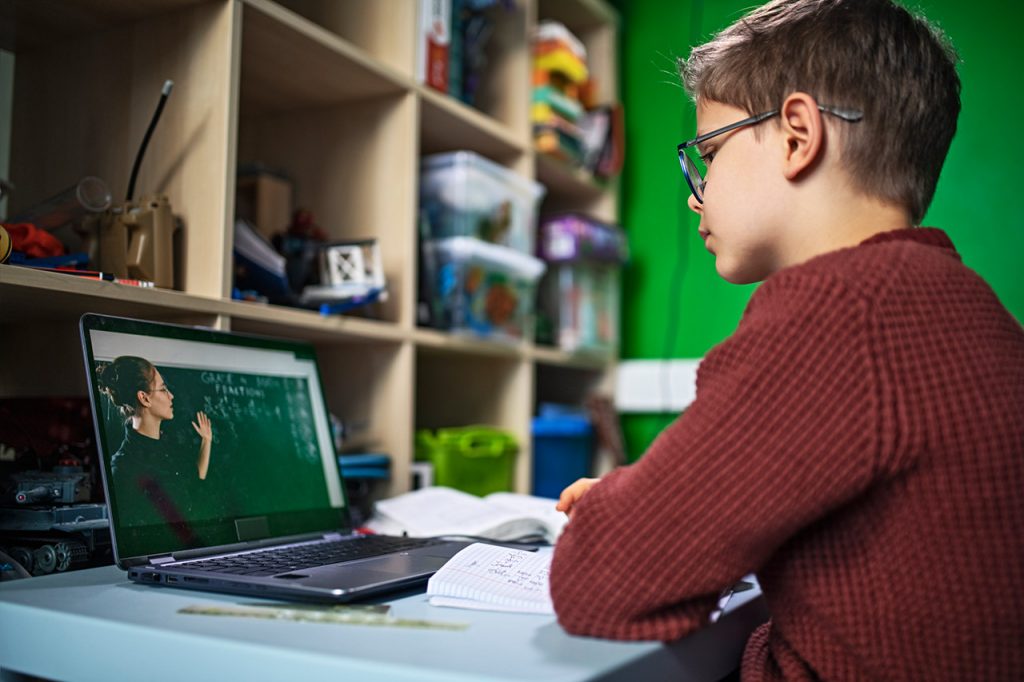So, here we are, faced by a series of challenges that none of us imagined even six months ago and that have, for many of us, meant our first foray into remote teaching. While distance learning for adults has in recent years come into its own, with the mushrooming of apps, MOOCs, online degrees, tutorials and qualifications for everything from plumbing to printmaking, younger students have rarely been asked to cope with the complexities of remote lessons. It has taken the advent of Covid-19 to force us all to find ways to harness new and old technologies to support and encourage this new group of distance learners.
Despite the challenges, having to limit our face-to-face teaching can actually have positive effects on teaching and learning. To take full advantage of our limited contact hours we need to focus on how students can best prepare and learn on their own or in groups before and after we meet as a class. The proponents of the flipped classroom have demonstrated that this process can be a good way of coping with diverse learning needs, and can help even hitherto failing students to learn to learn, as they have time to get their teeth into new concepts without the pressure of keeping up in the traditional classroom.
In remote contexts, even more than in face-to-face classrooms, it’s evident that setting clearly defined objectives for each term, each week and each lesson is crucial. Programmes can be built around collaborative learning and research in pairs or small groups. The important thing is to focus first on what we want to achieve in our precious contact hours. The tasks we ask our students to complete on their own at their own pace are then centred on helping them grasp the concepts and acquire the knowledge they need to be able to participate actively in the group work we have planned.
For example, before an online English class we might ask students on their own to watch an animation of a song or story exemplifying the new language, encouraging them to watch several times until they can sing or read along fluently. They can then perform the song or story in their groups. Another pre-class activity could be to watch a vocabulary video or grammar animation as many times as they need, and attempt the linked practice activities to check that they have grasped the new language and concepts. Each student can then fully participate in any group project or collaborative activity we have set up, and derive full benefit from teacher-led classes, where we can focus on answering questions, helping with problems and reinforcing the key concepts.
Flipped learning facilitates all this because children can prepare or study for as long as they need before joining the wider group. But how do we know whether our students have actually mastered a concept? This is where a good online learning platform can help, by giving students a wealth of input and practice which they can use at their own pace, while allowing us to monitor an individual child’s or a group’s activity, track their progress and see at a glance which students need extra support or extension. If students are falling behind, we can see from the data and reports provided by the platform whether it’s because they aren’t putting in the hours or because they’re genuinely having difficulty grasping the concepts. A good platform also offers forums for group work and assignment and messaging features so that parents and students know what they have to do and by when.
Struggle as we may with the challenges 2020 has brought, they may yet give us the impetus to re-examine our teaching, and to find new ways to help all of our students to learn, and to learn in ways that will benefit them for the rest of their lives. RM

Entonces, aquí estamos, enfrentados a una serie de desafíos que ninguno de nosotros imaginaba ni siquiera hace seis meses y que, para muchos de nosotros, han significado nuestra primera incursión en la enseñanza a distancia. Si bien el aprendizaje a distancia para adultos se ha constituido en los últimos años, con la proliferación de aplicaciones, cursos en línea masivos y abiertos (MOOCs por sus siglas en inglés), títulos en línea, tutoriales y cualificaciones para todo, desde plomería hasta grabado, rara vez se ha pedido a los estudiantes más jóvenes que enfrenten las complejidades de las clases a distancia. Ha sido necesario la llegada de Covid-19 para obligarnos a todos a encontrar formas de aprovechar las nuevas y antiguas tecnologías para apoyar y alentar a este nuevo grupo de estudiantes a distancia.
A pesar de los desafíos, tener que limitar nuestra enseñanza presencial puede realmente tener efectos positivos sobre la enseñanza y el aprendizaje. Con el propósito de aprovechar al máximo nuestras limitadas horas de contacto, debemos centrarnos en cómo los estudiantes pueden prepararse y aprender mejor por sí mismos o en grupos, antes y después de reunirnos como clase. Los defensores del aula invertida han demostrado que este proceso puede ser una buena forma de hacer frente a diversas necesidades de aprendizaje, e incluso puede ayudar a los estudiantes que hasta ahora no han tenido éxito a aprender a aprender, ya que tienen tiempo para interiorizar nuevos conceptos sin la presión de mantener el paso del aula tradicional.
En contextos remotos, incluso más que en los presenciales, es evidente que el establecimiento de objetivos claros y definidos para cada periodo, cada semana y cada lección es crucial. Los programas se pueden construir bajo el aprendizaje e investigación colaborativa en parejas o en grupos pequeños. Lo importante es enfocarnos primero en lo que queremos lograr en nuestras valiosas horas de contacto. Los ejercicios que pedimos que nuestros estudiantes realicen por su cuenta y a su ritmo se centran en ayudar a captar los conceptos y adquieran el conocimiento que necesitan para poder participar activamente en el espacio grupal que hemos planeado.
Por ejemplo, antes de una clase de inglés en línea, podríamos pedirles a los estudiantes que vean por sí mismos una animación de una canción o historia que ejemplifique el nuevo lenguaje, animándolos a observarla varias veces hasta que puedan cantarla o leerla con fluidez. Luego, pueden interpretar la canción o la historia en grupos. Otra actividad previa a la clase podría ser observar un video de vocabulario o una animación gramatical tantas veces como sea necesario, e intentar responder las actividades de práctica vinculadas a las mismas para comprobar que han comprendido el nuevo lenguaje y conceptos. Luego, cada estudiante puede participar plenamente en cualquier proyecto grupal o actividad colaborativa que hayamos establecido y obtener el máximo beneficio de las clases dirigidas por el maestro, donde podemos enfocarnos en responder preguntas, ayudar con problemas y reforzar los conceptos clave.
El aprendizaje invertido facilita todo esto porque los niños pueden prepararse o estudiar por el tiempo que necesitan antes de unirse al grupo más amplio. Pero ¿cómo sabemos si nuestros estudiantes realmente han dominado un concepto? Aquí es donde una muy buena plataforma de aprendizaje en línea puede ayudar, brindando a los estudiantes una gran cantidad de insumos y prácticas que puedan realizar a su propio ritmo, mientras nosotros monitoreamos dichas actividades individual o grupalmente, realizamos seguimiento de su progreso e identificamos de un vistazo qué estudiantes necesitan apoyo o refuerzo. Si los estudiantes se están quedando atrás, podemos identificar a partir de los datos y los informes proporcionados por la plataforma el motivo por el cual esto sucede, si es porque no están dedicando el tiempo estimado o porque realmente tienen dificultades para comprender los conceptos. Una buena plataforma también ofrece foros para trabajo en grupo y funciones de asignación y mensajería para que los padres y los estudiantes sepan lo que deben hacer y para cuándo.
Aún cuando 2020 ha traído desafíos consigo mismo, estos pueden ofrecernos el impulso de volver a examinar nuestra enseñanza y de encontrar nuevas formas de ayudar a todos nuestros estudiantes a aprender, y de aprender de distintas maneras que los beneficien para el resto de sus vidas. RM




